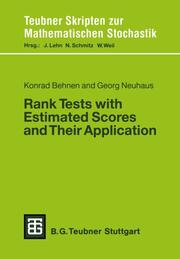Detailansicht
Rank Tests with Estimated Scores and Their Application
Teubner Skripten zur Mathematischen Stochastik
ISBN/EAN: 9783519027287
Umbreit-Nr.: 6593565
Sprache:
Deutsch
Umfang: ix, 418 S.
Format in cm:
Einband:
kartoniertes Buch
Erschienen am 01.01.1989
Auflage: 1/2013
- Zusatztext
- The general aim of this book is to present a new class of nonlinear rank tests for a variety of important testing problems. The need for such new procedures sterns from the fact that the classical linear rank tests are sensitive only for small classes of alternatives, while our nonlinear rank tests are designed to be sensitive for broad classes of alternatives. The development of the new proce dures is strongly influenced by the opinion that in many real world situations the classical shift assumption is too idealized. By introducing general nonpara metrie models we get rid of the shift assumption. For the two-sample situation a detailed motivation is given in Chapter l. Our theoretical results and many Monte Carlo simulations have convinced us that the proposed procedures are of real practical importance and should be used in statistical applications. Therefore in Chapter 2 we present a simple algorithmic description of the new rank tests-without stressing any mathe matical theory-and a step by step evaluation of numerical examples, whereas in Part 11 of the book (Chapters 2-6) we give a rigorous asymptotic theory of all proposals of Chapter 2. These chapters discuss different models and motivate the special proposals. Most of the concepts and of the theoretical results are based on our own work.
- Kurztext
- InhaltsangabeI Motivation and Applications.- 1 Introduction and Motivation.- 1.1 The shift model: A review.- 1.2 Generalized shift models.- 1.3 General alternatives.- 2 Applications.- 2.1 Two samples differing in location.- 2.2 Two samples differing in scale.- 2.3 Several samples on the real line.- 2.4 Several samples on the circle.- 2.5 Two samples under type II censoring.- 2.6 The hypothesis of symmetry.- 2.7 The hypothesis of independence.- II Mathematical Foundation.- 3 Two samples differing in location.- 3.1 Kernel estimators of the score function.- 3.2 Projection estimators of the score function.- 3.3 Treatment of ties.- 4 Randomness versus related alternatives.- 4.1 Two samples differing in scale.- 4.2 Several samples on the real line.- 4.3 Several samples on the circle.- 4.4 Two samples under type II censoring.- 5 The hypothesis of symmetry.- 5.1 Linear rank tests.- 5.2 Kernel estimators of the score function.- 5.3 Projection estimators of the score function.- 5.4 Treatment of ties.- 6 The hypothesis of independence.- 6.1 Linear rank tests.- 6.2 Kernel estimators of the score function.- 6.3 Projection estimators of the score function.- 6.4 Treatment of ties.- 7 Appendix.- 7.1 Proof of Theorem 3.0.1.- 7.2 Proof of Proposition 3.2.1.- 7.3 A characterization of monotone functions.- 7.4 Proof of formulae (3.2.32) and (3.2.33).- 7.5 Linear interpolation.- 7.6 Proof of inequality (4.2.22).- 7.7 Proof of Theorem 4.2.2.- 7.8 Proof of Theorem 5.2.1.- 7.9 Proof of inequality (6.2.33).- Tables.- Author Index.- of Program Disks.
